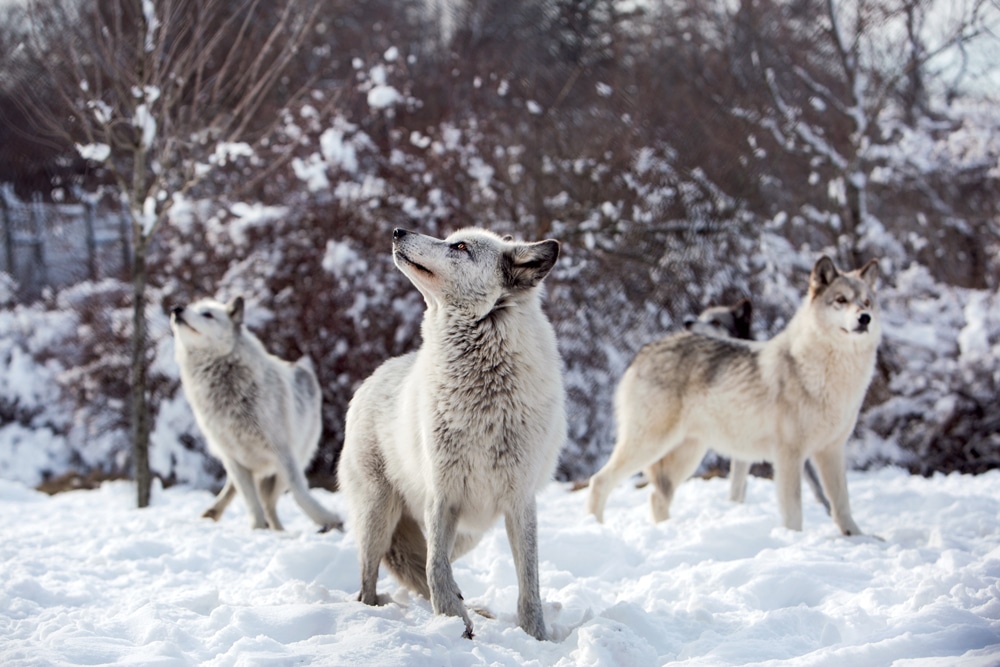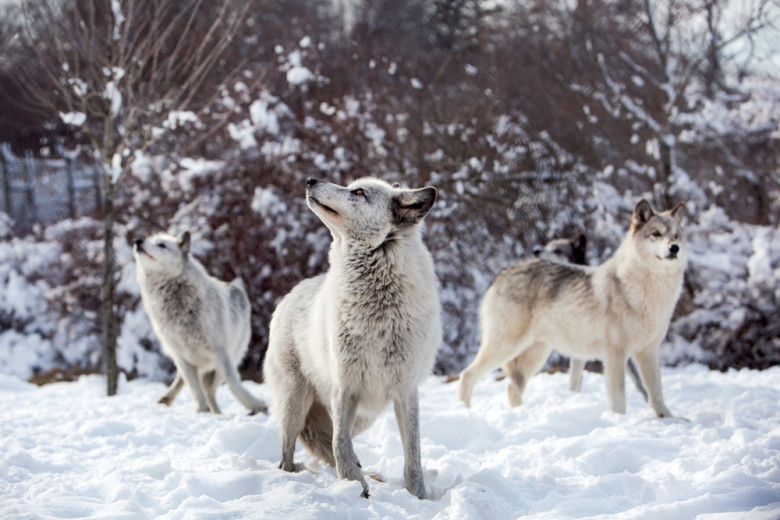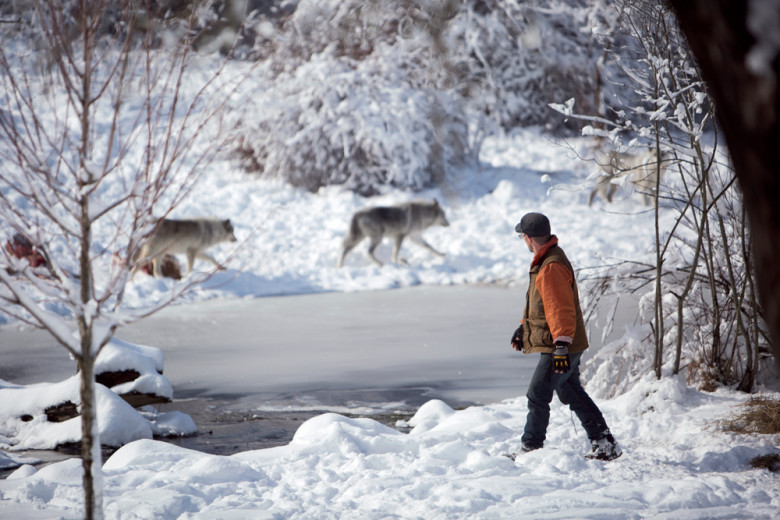The Wolves of Winter | First Light
What happens at Wolf Hollow sanctuary in Ipswich, Massachusetts is a rewilding of the human heart.

Coffee By Design | Portland, Maine
Photo Credit : Katherine KeenanYou don’t just hear a wolf howl. You feel it.
Striding across the parking lot to the Wolf Hollow sanctuary in Ipswich, Massachusetts, I’m suddenly frozen in my tracks by a sound I’ve heard recordings of since I was a child—but now it is live. So familiar, yet so immediate, rich, real, and present. I have to hold still a moment to let my brain catch up with my ears.
The howling of a wolf.

Photo Credit : Kieran Kesner
I spy the source: a handsome gray-and-buff-colored wolf, who turns to regard me with golden eyes. He throws back his head and howls again, his pack now joining him from unseen regions of the sanctuary, their voices weaving a magic carpet of sound that floats out over the salt marshes.
On this winter Saturday, the sanctuary is busy readying for visitors. Even before volunteers open the gate, the parking lot spills over, and a queue that includes a Cub Scout troop and a vanful of geoscience undergraduates soon snakes out the visitors center’s door. The aura of wolves brings some 150 people to Wolf Hollow each weekend, even in winter, when they bundle up against the cold to watch the pack romp in the snow.
The Wolf Hollow pack numbers seven wolves plus a rescued wolf-dog hybrid named Bear. Four live in the main enclosure: Argus, the handsome howler; his brothers, Grendel and Arrow; and their sister Neveah. Another sister, Linnea, thrives in her own enclosure, where she won’t be dominated by Neveah. Their adoptive aunt, Jelly, the archetypal lone wolf, also has her own space; Osa, another “aunt,” lives with Bear. All the wolves were born in captivity at other sanctuaries, and all have been spayed or neutered.
The sanctuary was founded in 1990 by Paul Soffron, who passed away in 2001 at age 58 from early-onset Alzheimer’s. He created the North American Wolf Foundation, of which Wolf Hollow is the headquarters, “to preserve the wolf in the wild through education and exposure.” Today his widow, Joni, and his son, Zee, carry on.
Although New England is now so thickly settled that wolf reintro-duction is doubtful here, early settlers knew their cry. Gray wolves were dominant predators in the indigenous ecosystem, their lives entwined with those of the native people; the members of the Mohegan Nation, for example, still consider themselves “Wolf People.” But as European settlers encroached on forests and hunted the same food wolves needed, wolves themselves became prey. In 1630 the Massachusetts Bay Colony set its first bounty—reputedly two bushels of corn or a bottle of whiskey for each wolf killed—and in 1897 the last wild wolf was shot in New England.

Photo Credit : Kieran Kesner
At Wolf Hollow, the program begins. Volunteers wearing wolf-gray shirts sit alertly under the trees as Zee addresses the rapt crowd. He pitches chunks of frozen deer hearts over his shoulder to tempt the wolves from the underbrush. The wolves emerge, easily jogging back and forth, their narrow-keel chests and long legs built for travel. Their fur, thicker over their shoulders in distinctive capes, ripples in the afternoon light. It takes them all of a second to size up the crowd as not being a threat, but, as wild creatures, they still do not get too near. With their long jaws, they snap up the nuggets of heart from the ground.
Zee tells the crowd about the beautiful things that these wolves do, like sleeping on the pond in the enclosure when it’s iced over, and of the intricate, efficient, and peacefully maintained family structures of wolves in general. To demonstrate a custom of the wolf world—scent-rolling to communicate with fellow pack members about an intriguing find—Zee hunkers down and squirts Axe body spray on a patch of earth. Argus circles the puddle of scent, then dives into it, joyfully wriggling, smearing it with cheeks and flanks, ears and elbows. His sister and brothers gather to check him out, snuffling his fur, whuffing, plumed tails waving.
When the presentation ends, Joni tells me how her late husband started Wolf Hollow. Paul Soffron was a lifelong outdoorsman and clam digger until a drunk driver struck and disabled him in 1982. A painter of wolves in his childhood—“In first grade his teacher told him, ‘You’re not going to make it to second grade if you keep drawing wolves and Indians’”—he took art classes and started painting wolves again as therapy following the accident. After having to clarify elements of lupine anatomy to his classmates, he realized how little people knew about wolves. He thought he could change that. He attended intensive seminars to educate himself about wolf care, all the while envisioning a sanctuary. Says Zee, “Everyone thought he was crazy.”
“You grew up with wolves? I bet you were the coolest boy in school,” I remark. Zee bursts out laughing. “Are you kidding? They called me Teen Wolf and Wolf Boy!”

Photo Credit : Kieran Kesner
Twenty-five years later, that perception might be different. Even as wolves elsewhere remain under threat from hunting and habitat loss, the Soffrons note a significant change in people’s attitudes. Zee always asks the crowd how many think wolves are dangerous. “The response used to be 80 percent yes, 20 percent no,” he says. “Now it’s the opposite.” He attributes the shift to education and the spread of information on social media.
Today the absence of wolves in New England may be felt in many ways. For instance, a burgeoning deer population might be contributing to a dramatic increase in Lyme disease, which is carried by ticks that feed on deer. And the recent rise in the number of Eastern coyotes could represent a recalibration of nature—that is, filling the niche left by wolves.
But whether or not wolves return to the larger landscape, what happens at Wolf Hollow is definitely a rewilding of the human heart. “Driving up 133, I still get butterflies when I see that red fence,” says Niki Tracchia, a 29-year-old volunteer with purple streaks in her ponytail who handles the sanctuary’s social media. Returning visitors ask after individual wolves by name. One fourth-grade girl was so inspired by her visit that she drew pictures of wolves, sold them to her classmates for a quarter each, and donated the resulting $6.50 to the sanctuary. Programs for abused teenagers send participants to observe the wolves as part of their therapy.
After a trip through the gift shop, children rush excitedly to their parents’ cars clutching plush wolves to their chests. Joni, who lives every day alongside the real ones, watches them go. “I think sometimes we take it for granted,” she reflects. “It can take someone outside of you to remind you of what a privilege it is to walk among the wolves, to be one with them, to be accepted into their world.”
Wolf Hollow. 114 Essex Road, Ipswich, MA. 978-356-0216; wolfhollowipswich.org.
SEE MORE: Wolf Hollow Gray Wolf Sanctuary in Ipswich, Massachusetts | Photographs







